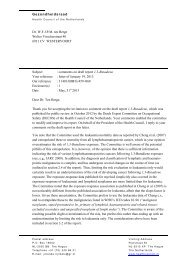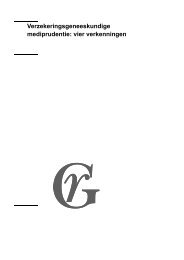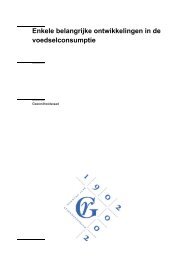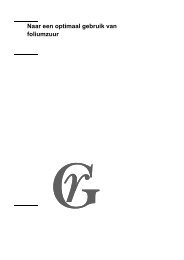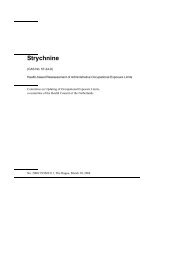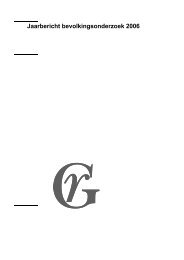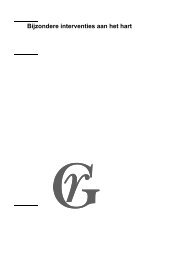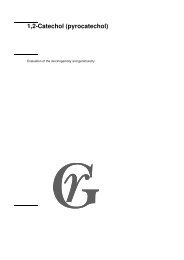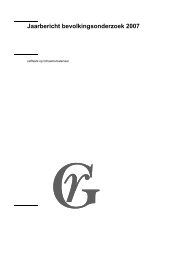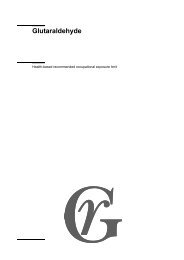Liquefied petroleum gas (LPG) - Gezondheidsraad
Liquefied petroleum gas (LPG) - Gezondheidsraad
Liquefied petroleum gas (LPG) - Gezondheidsraad
Create successful ePaper yourself
Turn your PDF publications into a flip-book with our unique Google optimized e-Paper software.
2 Identity<br />
name : liquefied <strong>petroleum</strong> <strong>gas</strong> propane butane<br />
synonyms : <strong>LPG</strong>; <strong>petroleum</strong> <strong>gas</strong>;<br />
bottled <strong>gas</strong><br />
n-propane; dimethylmethane;<br />
propyl hydride; propyl dihydride<br />
n-butane; butylhydride;<br />
methylethylmethane; diethyl<br />
molecular formula : C 3<br />
H 8<br />
C 4<br />
H 10<br />
structural formula : CH 3<br />
-CH 2<br />
-CH 3<br />
CH 3<br />
-CH 2<br />
-CH 2<br />
-CH 3<br />
CAS number : 68476-85-7 a<br />
74-98-6 106-97-8<br />
a<br />
CAS does not treat this substance as a unique chemical entity in its regular CA index processing.<br />
3 Physical and chemical properties<br />
<strong>LPG</strong> propane n-butane<br />
molecular weight 42-58 44.09 58.12<br />
boiling point >-44 o C -42.1 o C -0.5 o C<br />
melting point not available -189.7 o C -138.2 o C<br />
flash point not found -104 o C (closed cup) -60 o C (closed cup)<br />
vapour pressure >100 kPa at 21 o C: 853 kPa at 25 o C: 243 kPa<br />
solubility in water insoluble insoluble insoluble<br />
log P octanol/water<br />
not available 2.36 (experimental)<br />
1.81 (calculated)<br />
2.89 (experimental)<br />
2.31 (calculated)<br />
conversion factors<br />
at 20 o C, 101.3 kPa:<br />
1 mg/m 3 = 0.54 ppm<br />
1 ppm = 1.84 mg/m 3<br />
at 20 o C, 101.3 kPa:<br />
1 mg/m 3 = 0.41 ppm<br />
1 ppm = 2.42 mg/m 3<br />
Data from ACG02a, ACG02b, ACG02c, Ber95a, Ber95b, CON92, NLM04a, NLM04b, http://www.syrres.com/esc/<br />
est_kowdemo.htm.<br />
<strong>LPG</strong><br />
<strong>LPG</strong> is a by-product of <strong>petroleum</strong> refining. It is a colourless <strong>gas</strong> with a mild<br />
odour. An odour threshold ranging from 5000-20,000 ppm has been reported. A<br />
foul odorant (e.g., ethanethiol) is added commercially. <strong>LPG</strong> is highly flammable<br />
and is a dangerous fire and explosive hazard (ACG02a).<br />
<strong>LPG</strong> is commercially available as propane (often found in colder climates),<br />
butane (more widely found in the Southern States of the USA due to its higher<br />
freezing and boiling points), and butane-propane mixtures (ACG02a). Others<br />
state that <strong>LPG</strong> is predominantly a mixture of C 3<br />
and C 4<br />
hydrocarbons with other<br />
hydrocarbons in the C 1<br />
-C 7<br />
range. These are <strong>gas</strong>es at normal ambient<br />
temperatures and pressures (CON92). In the Netherlands, <strong>LPG</strong> is blended by the<br />
Shell Company mainly from propane/propene and butane/butene refinery<br />
streams, both streams consisting for >90% of C 3<br />
or C 4<br />
molecules, respectively.<br />
134-4 Health-based Reassessment of Administrative Occupational Exposure Limits




